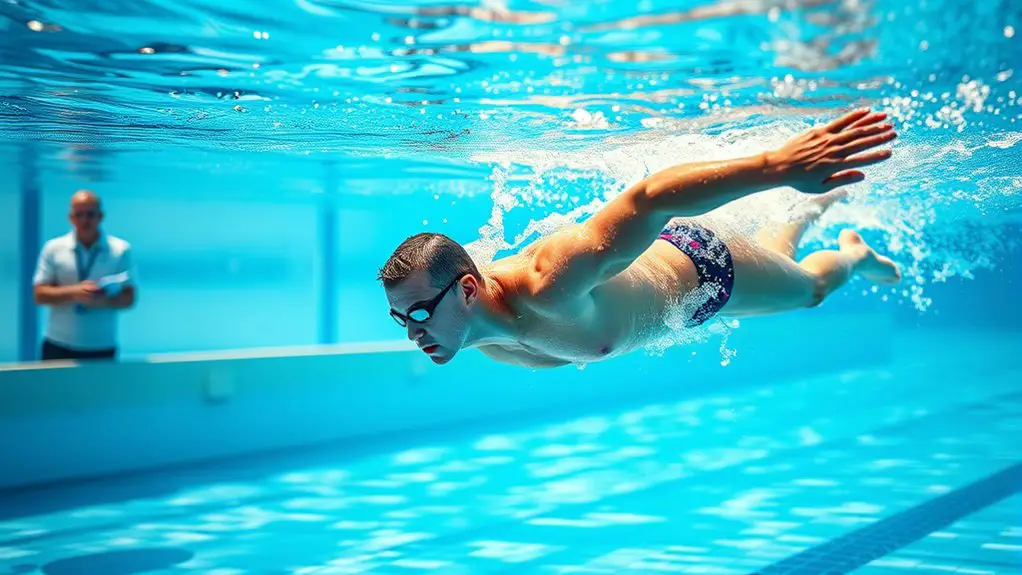To optimize your performance as a competitive swimmer, focus on goal setting, dryland training, and technique drills. Incorporate interval training for endurance and strength training to enhance power. Don't forget nutrition—balance your meals and stay hydrated. Mental training and visualization can boost your confidence and focus while recovery techniques help prevent injuries. By understanding these key areas, you can take your swimming to the next level and discover even more effective strategies.
Importance of Setting Goals
Setting goals is essential for any competitive swimmer aiming for success. Without clear targets, you might feel lost in your training. Goals give you a sense of direction, making your daily practices more focused and purposeful. They help you track your progress and celebrate small victories along the way, which fuels your motivation.
When you set specific, measurable, achievable, relevant, and time-bound (SMART) goals, you create a roadmap to freedom in your swimming journey. You'll know exactly what you're pursuing, whether it's improving your time, mastering a technique, or competing at a higher level. Additionally, breaking down larger aspirations into smaller, achievable milestones can significantly enhance your confidence and motivation throughout your training.
Incorporating Dryland Training
While swimming in the pool is essential for honing your technique and speed, incorporating dryland training can greatly enhance your overall performance. Dryland exercises not only improve strength and flexibility but also help in injury prevention. By integrating these workouts into your routine, you'll gain a competitive edge. This approach supports core stability and strength, which is crucial for all athletes.
Here's a simple table to illustrate effective dryland training exercises:
| Exercise | Benefits | Frequency |
|---|---|---|
| Bodyweight Squats | Builds leg strength | 2-3 times/week |
| Planks | Improves core stability | 3 times/week |
| Resistance Bands | Enhances muscle endurance | 2-3 times/week |
| Medicine Ball Throws | Boosts explosive power | 2 times/week |
These exercises offer a flexible way to strengthen your body without being confined to the pool. Embrace this freedom, and watch your performance soar!
Technique Drills for Stroke Improvement
To elevate your swimming skills, incorporating specific technique drills is essential for stroke improvement. These drills help refine your movements, ensuring efficiency and power in the water. Start with the catch-up drill for freestyle, where one arm remains extended while the other strokes. This promotes proper body rotation and arm extension.
Next, try the fingertip drag drill, which encourages high elbows and a relaxed hand entry, enhancing your overall stroke mechanics. For breaststroke, focus on the "glide" drill, allowing your body to stretch out between strokes, optimizing your timing.
Incorporate underwater dolphin kicks to boost your kick efficiency, especially for butterfly and freestyle. Remember to pay attention to your breathing patterns and body position during each drill. By consistently practicing these technique drills, you'll not only feel more fluid in the water but also gain the confidence to release your full potential during competitions.
Interval Training for Endurance
Incorporating interval training into your routine can greatly enhance your endurance as a competitive swimmer. This technique involves alternating between high-intensity bursts and lower-intensity recovery periods. You won't just build stamina; you'll also improve your speed and overall performance in the water.
Try starting with shorter intervals, like 50 meters at a fast pace, followed by a brief rest. As you get comfortable, gradually increase the distance and intensity. This method keeps your training engaging and helps push your limits without overwhelming you.
Listen to your body—if you feel fatigued, it's okay to adjust your intervals or rest longer. Remember, the goal is to develop endurance while feeling free and energized in your training. Consistency is key, so make interval training a regular part of your schedule, and watch how your endurance soars, giving you the competitive edge you've been seeking. Additionally, embracing the rhythm of intensity and recovery can further enhance your training experience.
The Role of Strength Training
Strength training is essential for competitive swimmers like you, as it enhances power and efficiency in the water. Focusing on key exercises can help target the muscles you use most while swimming. Plus, knowing how often to train and allowing for recovery will guarantee you get the most out of your strength workouts. Incorporating upper-body strength into your training routine can significantly improve your swimming performance and reduce the risk of injury.
Benefits of Strength Training
While you might think of swimming as primarily a cardiovascular sport, incorporating strength training into your routine can greatly enhance your performance in the water. By building muscle, you'll increase your power, enabling you to propel yourself faster through each stroke. Strength training also boosts your endurance, allowing you to maintain peak performance longer during races. Furthermore, it helps prevent injuries by strengthening the muscles around your joints, giving you more freedom to push your limits without the worry of setbacks. You'll find that improved core stability enhances your body position, reducing drag. Ultimately, strength training shifts your swimming game into high gear, equipping you with the tools needed to excel and enjoy the thrill of competition.
Key Exercises for Swimmers
To maximize your swimming performance, focusing on key exercises can make a significant difference. Incorporating strength training into your routine isn't just about bulking up; it's about enhancing your power and efficiency in the water. Think about exercises like pull-ups, which build upper body strength for better strokes. Squats and lunges target your legs, improving your kick and overall stability. Don't overlook core workouts like planks and medicine ball throws, as they'll provide the foundation for a strong swimming posture. Resistance bands can also help with shoulder stability, essential for preventing injuries. By integrating these exercises, you'll not only get stronger but also feel more liberated in your movements, allowing you to glide through the water with ease and confidence.
Training Frequency and Recovery
Balancing your training frequency with adequate recovery is essential for maximizing performance in competitive swimming. Overtraining can lead to burnout and injuries, so listen to your body. Incorporating strength training into your routine can enhance your swimming efficiency, but it's important to schedule rest days. Aim for consistency, targeting both swimming and strength workouts around four to six times a week. You'll find that alternating hard and easy days fosters better recovery while building strength. Prioritize nutrition and sleep, as they play a significant role in recovery. Embrace the freedom to adjust your schedule based on how you feel—sometimes, a lighter day is just what you need to come back stronger and ready to conquer the next challenge.
Flexibility and Mobility Workouts
Flexibility and mobility are key components in a swimmer's training regimen. They help improve your range of motion and reduce the risk of injury, allowing you to perform at your best. Incorporating effective mobility exercises into your routine can enhance your overall performance in the water.
Importance of Flexibility
While many swimmers focus on strength and endurance, incorporating flexibility into your training routine is just as essential. Flexibility enhances your range of motion, allowing for smoother, more efficient strokes. It helps prevent injuries, which can derail your progress and freedom in the water. When you're flexible, you can move more freely and powerfully, maximizing your performance during races. Stretching regularly not only increases your mobility but also aids in recovery after intense workouts, keeping your body feeling fresh. Think of flexibility as a key that reveals your full potential as a swimmer. By prioritizing it, you're setting the foundation for improved technique and speed, ensuring you can glide through the water effortlessly and enjoy every moment of your training.
Effective Mobility Exercises
To enhance your swimming performance, incorporating effective mobility exercises into your routine is essential. These exercises help you achieve greater flexibility and movement efficiency, allowing for smoother strokes and improved speed in the water. Consider dynamic stretches like arm circles and leg swings before your workouts to warm up your muscles. Post-training, focus on static stretches such as the butterfly stretch or chest opener to release tension. Yoga can also be a game-changer, enhancing both flexibility and mental focus. Remember, it's about finding what feels right for your body. Integrating these mobility workouts into your regimen not only boosts performance but also provides a liberating sense of freedom in your strokes, letting you glide effortlessly through the water.
Nutrition and Hydration Strategies
Nutrition and hydration play an essential role in optimizing your performance as a competitive swimmer. To fuel your body effectively, consider these strategies:
Nutrition and hydration are crucial for enhancing performance in competitive swimming.
- Balanced Meals: Incorporate a mix of carbohydrates, proteins, and healthy fats to support energy levels and recovery.
- Pre-Workout Nutrition: Eat a light meal or snack rich in carbs about 30-60 minutes before practice to boost your energy without feeling weighed down.
- Hydration: Aim for at least 2-3 liters of water daily, adjusting based on your training intensity. Don't forget electrolyte-rich drinks, especially after long sessions. Proper hydration helps avoid fatigue and cramps that can hinder performance.
- Post-Workout Recovery: Consume a meal or shake with protein and carbs within 30 minutes after training to help your muscles recover and replenish glycogen stores.
Mental Training and Visualization Techniques
Mental training is just as important as physical training for competitive swimmers. You can boost your performance through visualization techniques, effective goal setting, and positive self-talk. Let's explore how these strategies can help you achieve success in the pool. Incorporating visualization techniques into your training routine can significantly enhance your focus and confidence, preparing you for peak performance during competitions.
Visualization for Success
Success in competitive swimming often hinges not just on physical prowess but also on the power of visualization. By harnessing this mental tool, you can reveal your full potential. Here are some techniques to enhance your visualization practice:
- Create a Clear Image: Picture yourself swimming flawlessly, from the start to the finish.
- Engage Your Senses: Feel the water, hear the crowd, and embrace the thrill of competition.
- Practice Regularly: Dedicate a few minutes daily to visualize your goals and techniques.
- Stay Positive: Focus on successful outcomes, reinforcing confidence and reducing anxiety.
Embrace visualization as an essential part of your training. With practice, you'll find it becomes a powerful ally in achieving your swimming aspirations.
Goal Setting Strategies
Setting clear and achievable goals is essential for any competitive swimmer looking to enhance their performance. You should break down your long-term aspirations into smaller, manageable milestones. This approach makes it easier to track progress and celebrate victories along the way. Consider setting specific, measurable, attainable, relevant, and time-bound (SMART) goals that align with your overall vision.
Visualizing your success can also help in this process. Picture yourself achieving each goal, whether it's mastering a technique or hitting a personal best. This mental imagery reinforces your commitment and boosts your confidence. Remember, it's not just about the destination but also the journey. So, embrace the process, adapt as needed, and let your goals guide you toward the freedom of your best performance.
Positive Self-Talk Techniques
Many competitive swimmers underestimate the power of positive self-talk in their training routines. Harnessing this technique can boost your confidence and enhance your performance. Here are four effective positive self-talk strategies you can use:
- Affirmations: Create short, powerful statements that resonate with you, like "I am strong" or "I swim with purpose."
- Visualization: Picture yourself succeeding in your races, feeling the water and your movements perfectly aligned.
- Reframing: Turn negative thoughts into positive ones, like changing "I can't do this" to "I'm learning and improving."
- Encouragement: Speak to yourself as you would to a teammate, offering support and motivation during tough moments.
Recovery and Injury Prevention
As you push your limits in the pool, prioritizing recovery and injury prevention becomes essential for your long-term success. You want to swim freely and fiercely, but neglecting recovery can lead to burnout or injuries that restrict your progress. Incorporate rest days into your training schedule; they're not a sign of weakness but a pathway to strength.
Active recovery techniques, like light swimming or yoga, can help keep your body engaged without overexerting yourself. Stretching and foam rolling are also important; they release tension and enhance flexibility, reducing your injury risk. Listen to your body—if something feels off, don't hesitate to address it. Proper nutrition strategies, such as protein intake for recovery, play a significant role too; fueling your body with the right nutrients aids recovery. Hydration shouldn't be overlooked either; staying well-hydrated keeps your muscles functioning effectively. Embrace these practices, and you'll find the freedom to push harder, swim faster, and achieve your goals.
Analyzing Performance Metrics
Understanding your performance metrics is essential for any competitive swimmer. It helps you track your progress and fine-tune your training. By analyzing these metrics, you gain insights into your strengths and areas for improvement. Here's what you should focus on:
Understanding your performance metrics is crucial for tracking progress and enhancing your training as a competitive swimmer.
- Splits: Track your lap times to see how consistent you are.
- Stroke Rate: Measure how many strokes you take per minute to optimize your efficiency.
- Heart Rate: Monitor your heart rate during training to guarantee you're pushing yourself appropriately.
- Distance per Stroke: Calculate how far you swim for each stroke to enhance your technique.
Frequently Asked Questions
How Often Should I Change My Training Routine?
Why stick to the same old routine when variety keeps things fresh? You should change your training routine every 4-6 weeks to stay motivated and prevent plateaus. Embrace the freedom of new challenges!
What Are the Best Swimming Drills for Beginners?
When you're starting out, focus on drills like the flutter kick, arm strokes, and breathing exercises. These'll build your foundation, helping you feel more comfortable in the water while enhancing your overall swimming technique.
How Do I Track My Progress Effectively?
To track your progress effectively, keep a detailed log of your workouts, noting times, distances, and techniques. Regularly review this data, celebrating improvements and adjusting your goals to maintain motivation and freedom in your training journey.
What Equipment Is Essential for Training?
You might think you need tons of gear, but it's simpler. Just a good pair of goggles, a kickboard, fins, and a stopwatch can elevate your training, giving you the freedom to swim your best.
How Can I Stay Motivated During Tough Training Sessions?
When you're feeling drained, focus on your goals and remember why you started. Break sessions into smaller parts, celebrate small victories, and surround yourself with supportive teammates. Keep your passion alive, and you'll push through!




